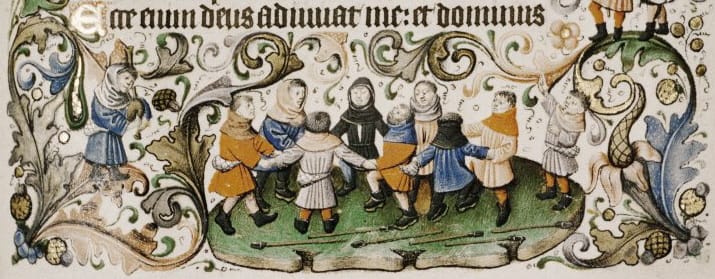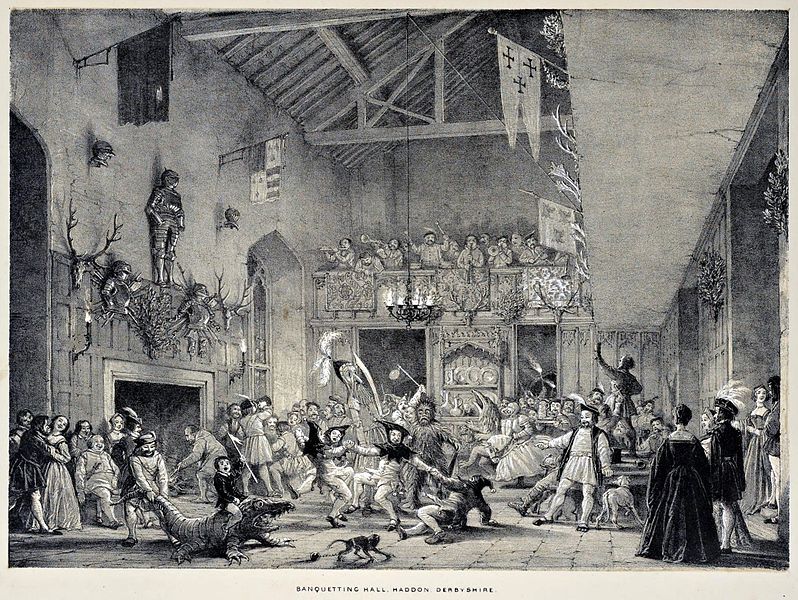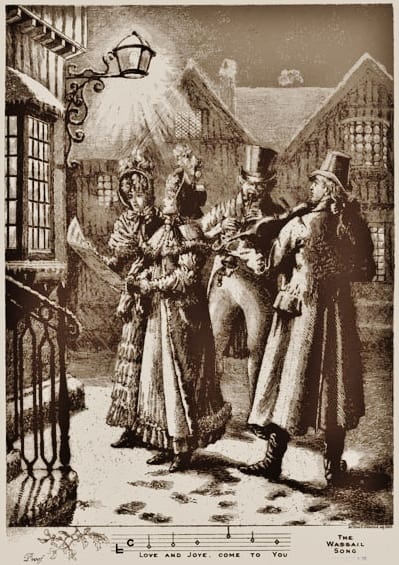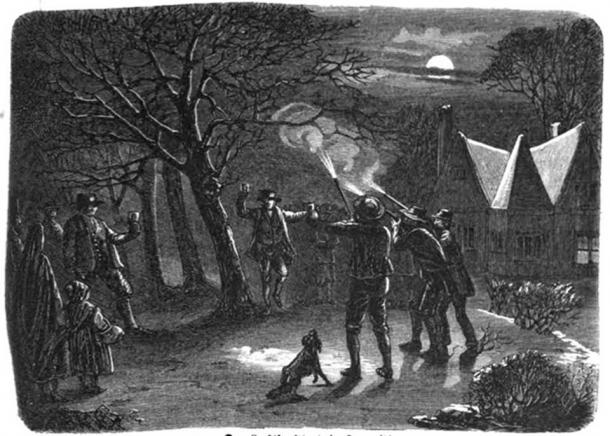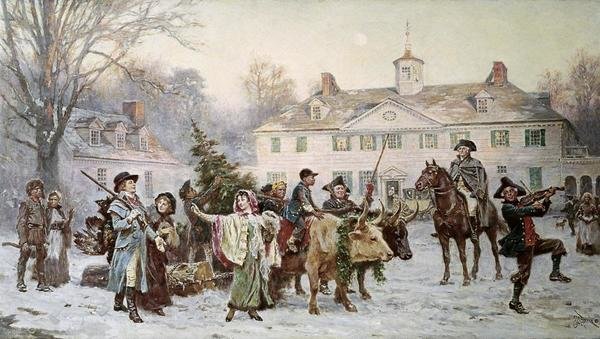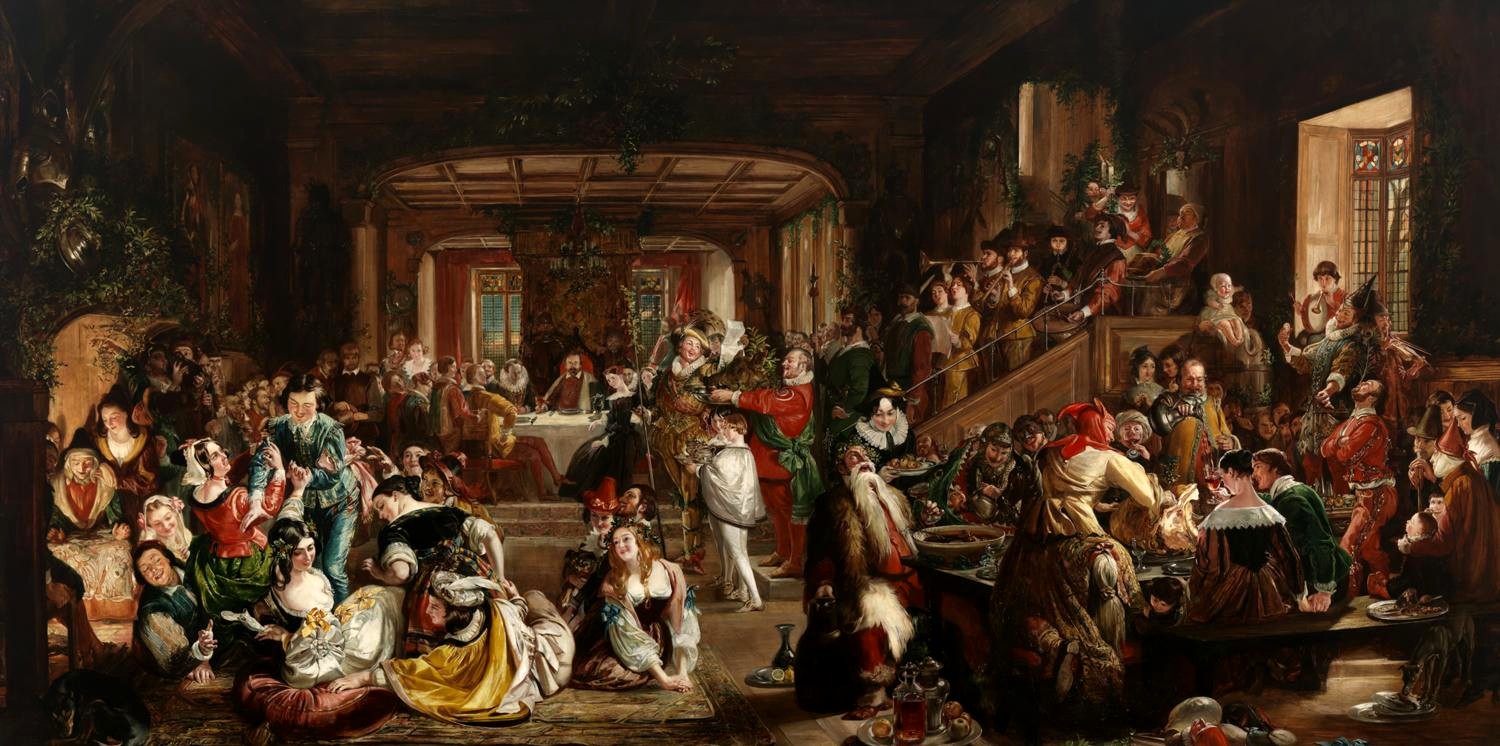COME, bring with a noise,
My merry, merry boys,
The Christmas log to the firing ;
While my good dame, she
Bids ye all be free ;
And drink to your heart’s desiring.
With the last year’s brandMy merry, merry boys,
The Christmas log to the firing ;
While my good dame, she
Bids ye all be free ;
And drink to your heart’s desiring.
Light the new block, and
For good success in his spending
On your psaltries play,
That sweet luck may
Come while the log is a-teending.
Ceremonies for Christmas by Robert Herrick (1591–1674)
(Psaltries: a kind of guitar, Teending: kindling)
No season has so much association with music as the
mid-winter, Christmas celebrations. The aural pleasure associated with
the tuneful music and carols of Christmas has been reduced in recent
years by the over-playing of same in shopping malls, banks, airports
etc. yet it is still enjoyed and the popularity of choirs has not
diminished.
However, the visual depictions of mid-winter, Christmas celebration
have also been popular since the 19th century through books, cinema and
television.The depictions of Christmas range from religious iconography through to the highly commercialised red-suited, rosy-cheeked, rotund Santa Claus.
Yet, between these two extremes of the sombre sacred and the commercialised secular lies a popular iconography best expressed in the realm of fine art and illustration.
Down through the centuries the pagan aspects of
mid-winter celebration and Christmas such as the Christmas tree, the
Yule log, wassailing and carol singing along with winter sports such as
ice skating and skiing have been depicted by many different artists.
These paintings and illustrations are also beloved for the visual pleasure they afford.
More importantly, they show aspects of Christmas which are becoming
more important now in our time of climate change. That is, their
depictions of our past respect for nature.
In recent times, as we gradually learned to harness
nature for our own ends through developments in science we also became
less and less worried about the vicissitudes of nature.
Our forebears, however, knew all too well hunger and
cold in the depths of winter and in their own religious and
superstitious ways tried to attenuate the worst of winter hardship
through traditions and practices which would ensure a bountiful
proceeding year.
For example, the Christmas Tree is a descendant of
the sacred tree which was respected as a powerful symbol of growth,
death and rebirth. Evergreen trees took on meanings associated with
symbols of the eternal, immortality or fertility (See my article on
Christmas Trees here).
Evergreen boughs and then eventually whole evergreen trees were brought
into the house to ward off evil influences. Burning the Yule log was an
important rite to help strengthen the weakened sun of midwinter.
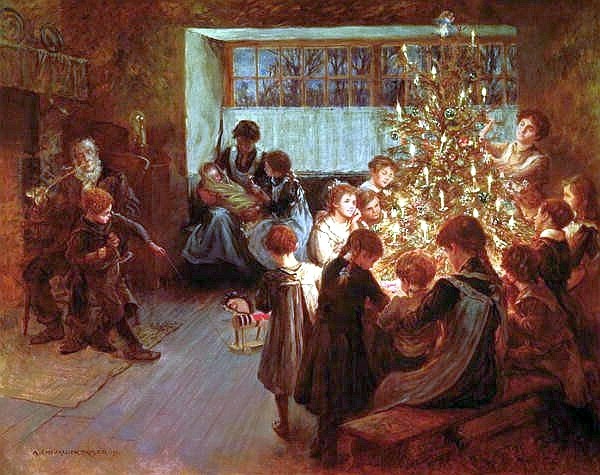
The Christmas Tree (1911)
Albert Chevallier Tayler (1862–1925)
Wassailing, or blessing of the fruit trees, is also
considered a form of tree worship and involves drinking and singing to
the health of the trees in the hope that they will provide a bountiful
harvest in the autumn. Mumming has also been associated with the spirit
of vegetation or the tree-spirit and is believed to have developed into
the practice of caroling even though mumming is alive and well in many
places in Ireland and England.
All these nature-based practices seem to have been
banned by the church at different times and then gradually integrated
into church rituals (presumably because the church was not able to stop
them).
Therefore our relationship with nature was demonstrated through
winter activities both inside and outside the home. Outside activities
consisted of ice skating, caroling, wassailing, bringing home the Yule
log and the Christmas tree.
Inside activities consisted of large gatherings of
family and friends eating, drinking and parlour games. The indulgence of
Christmas activities was balanced by an overriding concern that nature
had been propitiated or appeased.
One aspect the many depictions of these activities have in common is
the festive gathering of large groups of people. Modern depictions of
Christmas tend to emphasise the nuclear family gathered around the
Christmas tree with the focus on what Santa brought for the children.
Thus Christmas today is experienced as a more isolated experience than
in the past.
The decline of the nuclear family in recent decades
with single parent families, divorce, cohabitation, etc has created
extended family gatherings more akin to the past village groupings.
Outdoor activities have also declined though one can still hear
carollers singing on occasion, though still common in city streets.
Many artists of over the years have tried to depict the essence of
Christmas and midwinter traditions (see my article on midwinter
traditions here) and thus helped to keep them in our consciences.Let’s look at some of the illustrations and paintings that depict mid-winter festivities over the centuries.
Carols
Poetry and song are our earliest records of Christmas
celebrations. According to Clement Miles the word “‘carol’ had at first
a secular or even pagan significance: in twelfth-century France it was
used to describe the amorous song-dance which hailed the coming of
spring; in Italian it meant a ring- or song-dance; while by English
writers from the thirteenth to the sixteenth century it was used chiefly
of singing joined with dancing, and had no necessary connection with
religion.”[1]
The word carol itself comes from the Old French word
carole, a circle dance accompanied by singers (Latin: choraula). Carols
were very popular as dance songs and processional songs sung during
festivals. In medieval times the Church referred to caroling as “sinful traffic” and issued decrees against it in 1209 A.D. and 1435 A.D.
According to Tristram P. Coffin in his Book of Christmas Folklore,
“For seven centuries a formidable series of denunciations and
prohibitions was fired forth by Catholic authorities, warning Everyman
to ‘flee wicked and lecherous songs, dancings, and leapings’” (p98).
Mumming
The processional
aspects of caroling are linked to mumming, an ancient tradition which
was mentioned in early ecclesiastical condemnations.
During the Kalends of
January a sermon ascribed to St Augustine of Hippo writes that the
heathen reverses the order of things as some of these ‘miserable’ men
“are clothed in the hides of cattle; others put on the heads of beasts,
rejoicing and exulting that they have so transformed themselves into the
shapes of animals that they no longer appear to be men … How vile
further, it is that those who have been born men are clothed in women’s
dresses, and by the vilest change effeminate their manly strength by
taking on the forms of girls, blushing not to clothe their warlike arms
in women’s garments; they have bearded faces, and yet they wish to
appear women.” [2]
The original idea of
wearing the hides of animals, Miles writes, may have sprung “from the
primitive man’s belief ‘that in order to produce the great phenomena of
nature on which his life depended he had only to imitate them’. [3]
Indeed, in Ireland, mumming is a tradition that is still going strong.
In a recent article in The Fingal Independent, Sean McPhilibin notes that
“In North County Dublin the masking would be traditionally made from
straw and would have been big straw hats that cover the face and come
down to the shoulders.” McPhilibin also states that mumming was “a
mid-winter custom that in Ireland and North County Dublin and in parts
of England as well, the masking element is accompanied by a play. So
there’s a play in it with set characters. It’s a play where the
principal action takes place between two protagonists – a hero and a
villain. The hero slays the villain and the villain is revived by a
doctor who has a magical cure and after that happens there’s a
succession of other characters called in, each of whom has a rhyme. So
every character has a rhyme, written in rhyming couplets.[…] The other
thing to say about it is that you find these same type of characters all
across Spain, Portugal, France, Germany, Austria, Switzerland, over
into Slovenia and elsewhere.”
James Frazer, in The Golden Bough, discusses at length many
international examples of people being being completely covered in
straw, branches or leaves as incarnations of the tree-spirit or the
spirit of vegetation, such as Green George, Jack-in-the-Green, the
Little Leaf Man, and the Leaf King.[4]Wassail
There are two variations of wassailing: going from house to house singing and sharing a wassail bowl containing a drink made from mulled cider made with sugar, cinnamon, ginger and nutmeg, topped with slices of toast as sops or going from orchard to orchard blessing the fruit trees, drinking and singing to the health of the trees in the hope that they will provide a bountiful harvest in the autumn. They sing, shout, bang pots and pans and fire shotguns to wake the tree spirits and frighten away evil demons.
The wassail itself “is a hot, mulled punch often associated with Yuletide, drunk from a ‘wassailing bowl’. The earliest versions were warmed mead into which roasted crab apples were dropped and burst to create a drink called ‘lambswool’ drunk on Lammas day, still known in Shakespeare’s time. Later, the drink evolved to become a mulled cider made with sugar, cinnamon, ginger and nutmeg, topped with slices of toast as sops and drunk from a large communal bowl.” (See traditional wassail recipe here)
The Lord of Misrule
The Bean King
During the the Twelfth Night feast a
cake or pie would be served which had a bean baked inside. The person
who got the slice with the bean would be ‘crowned’ the Bean King with a
paper crown and appointed various court officials. A mock respect would
be shown when the king drank and all the party would shout “the king
drinks”. Robert Herrick mentions this in his poem Twelfth Night: or, King and Queen:
“NOW, now the mirth comesWith the cake full of plums,
Where bean’s the king of the sport here ;
Beside we must know,
The pea also
Must revel, as queen, in the court here.”

Twelfth-night (The King Drinks)
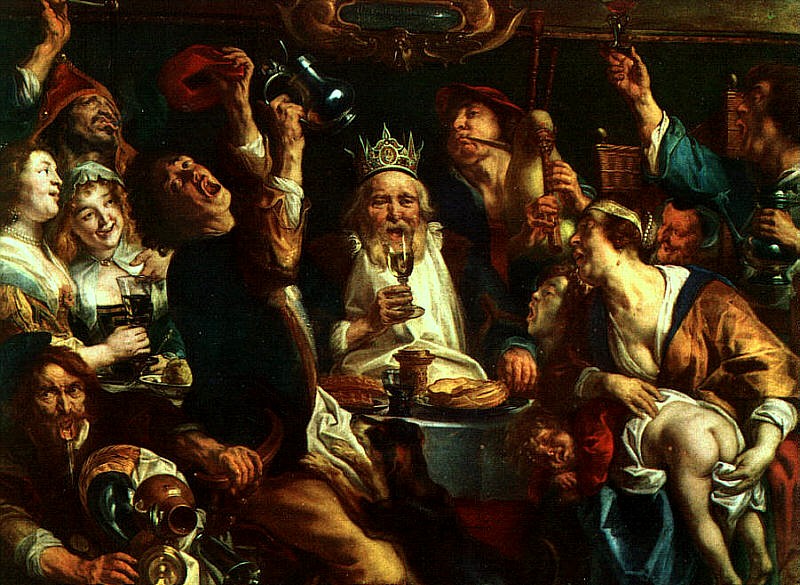
The King Drinks (c.1640)
Jacob (Jacques) Jordaens (1593–1678)
Merry Christmas in the Baron’s Hall (1838)
Maclise was influenced by Sir Walter Scott’s poem Marmion: A Tale of Flodden Field, published in 1808. Marmion is a historical romance in verse of 16th-century Britain, ending with the Battle of Flodden in 1513. Marmion has a section referring to Christmas festivities:
“The wassel round, in good brown bowls,
Garnish’d with ribbons, blithely trowls.
There the huge sirloin reek’d; hard by
Plum-porridge stood, and Christmas pie:
Nor fail’d old Scotland to produce,
At such high tide, her savoury goose.
Then came the merry maskers in,
And carols roar’d with blithesome din;
If unmelodious was the song,
It was a hearty note, and strong.
Who lists may in their mumming see
Traces of ancient mystery;
White shirts supplied the masquerade,
And smutted cheeks the visors made;
But, O! what maskers, richly dight,
Can boast of bosoms half so light!”
(See full text here)
It seems that Maclise was also taken enough by the poem
to pen his own poem about his painting which was published in Fraser’s
Magazine for May in 1838. The poem is titled: Christmas Revels: An Epic Rhapsody in Twelve Duans and
was published under the pseudonym, Alfred Croquis, Esq. The painting
includes over one hundred figures covering many different traditions of
Christmas and in his poem Maclise describes most of the activities
taking place as some these excerpts from the poem demonstrate:
“Before him, ivied, wand in hand,
Misrule’s mock lordling takes his stand;
[…]
Drummers and pipers next appear,
And carollers in motley gear;
Stewards, butlers, cooks, bring up the rear.
Some sit apart from all the rest,
And these for merry masque are drest;
But now they play another part,
Distinct from any mumming art.
[…]
First, Father Christmas, ivy-crown’d,
With false beard white, and true paunch round,
Rules o’er the mighty wassail-bowl,
And brews a flood to stir the soul:
That bowl’s the source of all their pleasures,
That bowl supplies their lesser measures”
(See full text here)Misrule’s mock lordling takes his stand;
[…]
Drummers and pipers next appear,
And carollers in motley gear;
Stewards, butlers, cooks, bring up the rear.
Some sit apart from all the rest,
And these for merry masque are drest;
But now they play another part,
Distinct from any mumming art.
[…]
First, Father Christmas, ivy-crown’d,
With false beard white, and true paunch round,
Rules o’er the mighty wassail-bowl,
And brews a flood to stir the soul:
That bowl’s the source of all their pleasures,
That bowl supplies their lesser measures”
Winter Landscapes
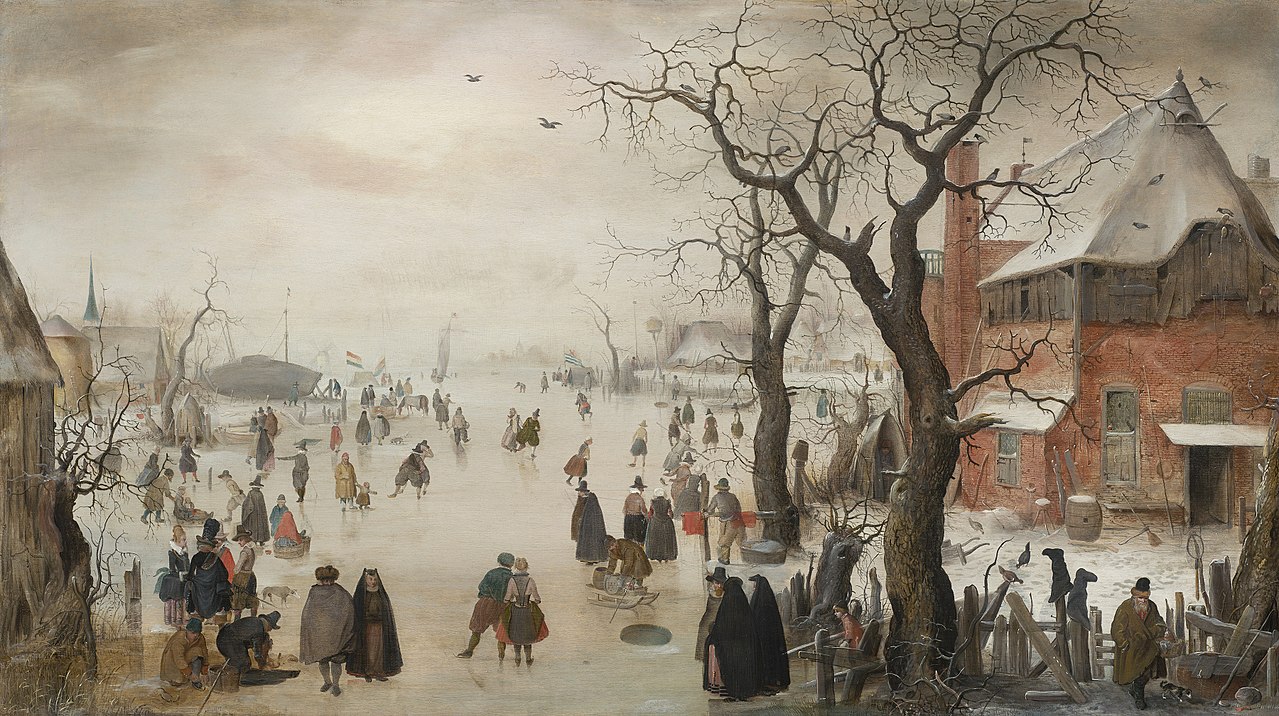
Winter Landscape near a Village
Hendrick Avercamp (1585 (bapt.) – 1634 (buried))

The Hunters in the Snow (1565)
Pieter Bruegel the Elder (c.1525-1530–1569)
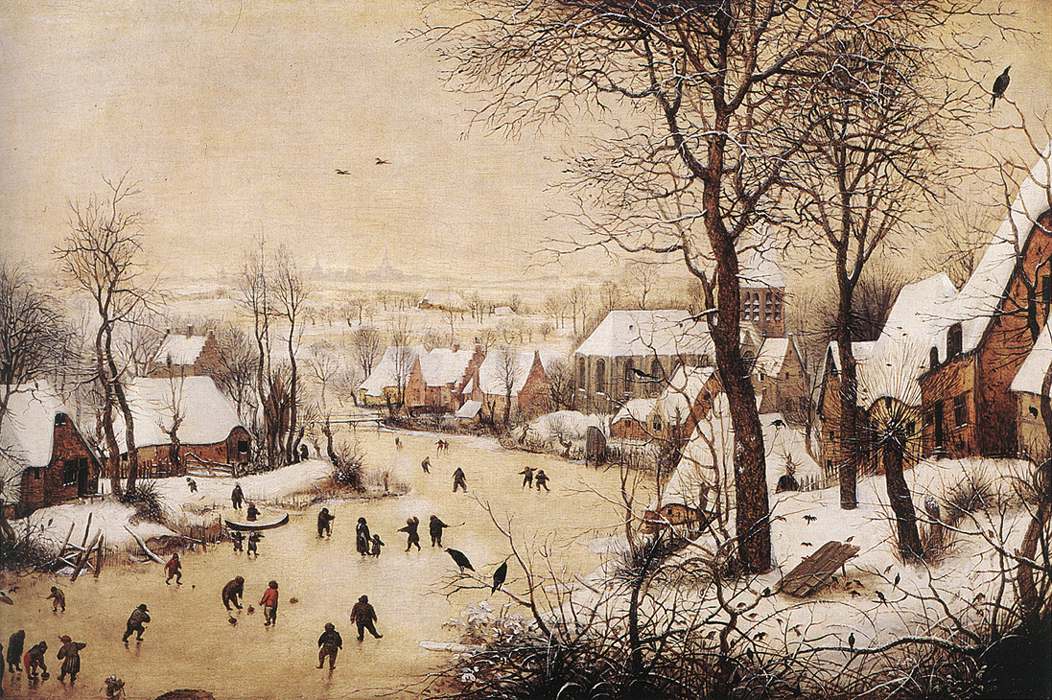
Winter Landscape with Skaters and Bird Trap (1565)
Pieter Bruegel the Elder (c.1525-1530–1569)
These famous winter landscape paintings by Pieter
Brueghel the Elder, such as The Hunters in the Snow and Winter Landscape
with Skaters and Bird Trap are all thought to have been painted in
1565. Hendrick Avercamp also made made many snow and ice landscapes
coinciding with the Little Ice Age. Three particularly cold intervals
have been described as
the Little Ice Age: “one beginning about 1650, another about 1770, and
the last in 1850, all separated by intervals of slight warming”.
Outdoor Activities: Skating, Markets and Fairs
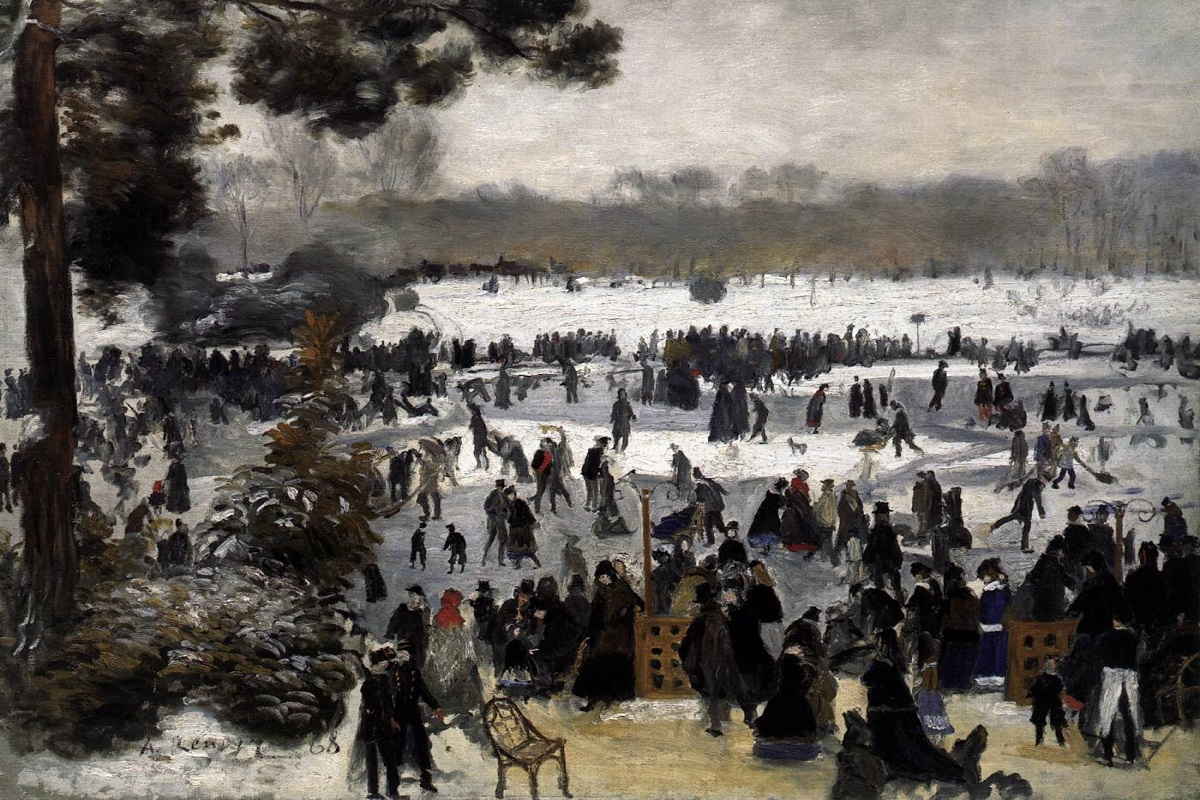
Patineurs au bois de Boulogne (1868)
Pierre-Auguste Renoir (1841–1919)
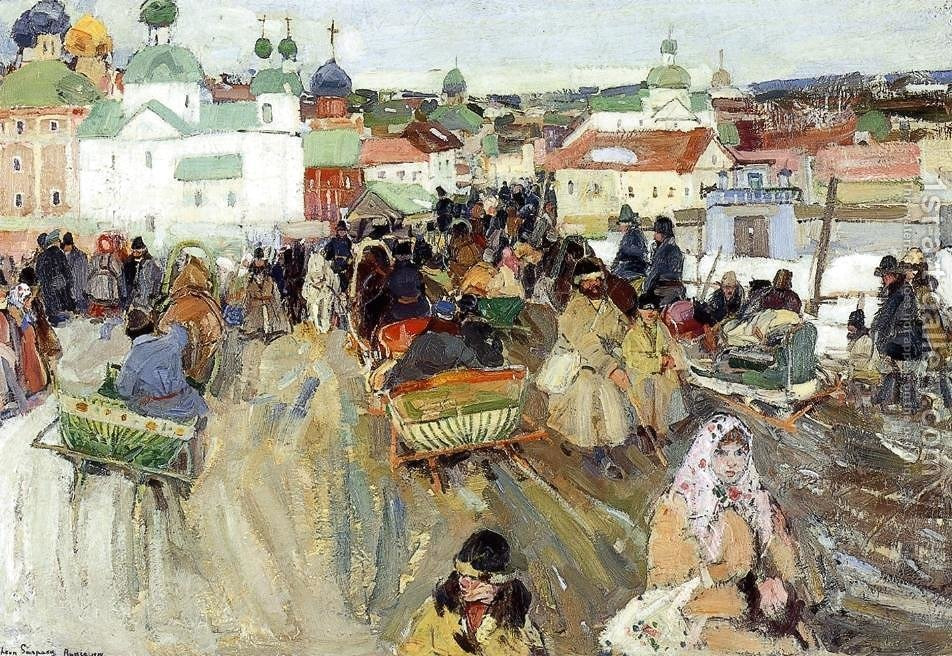
Russian Christmas
Leon Schulman Gaspard (1882-1964)
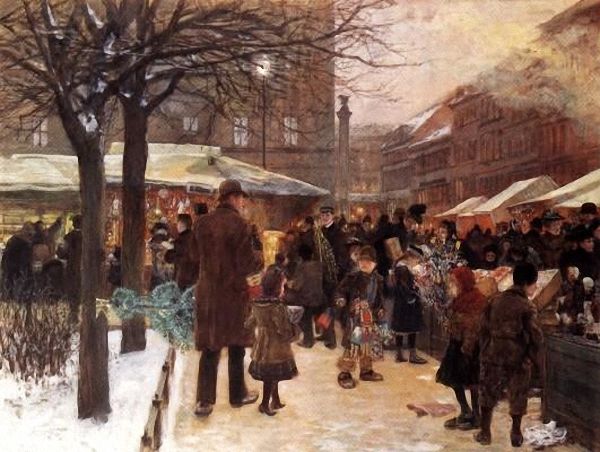
Franz Skarbina (1849-1910)
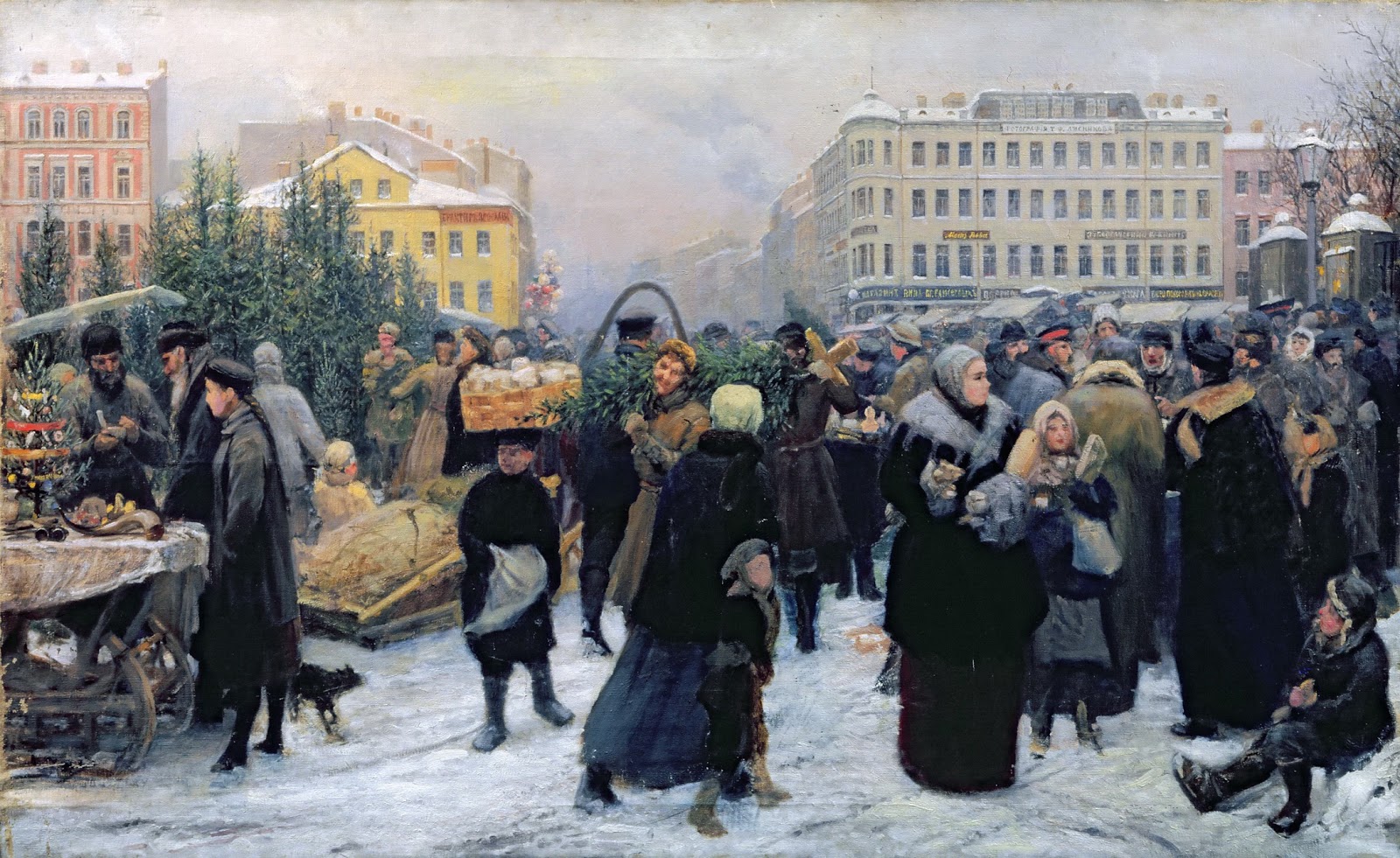
Christmas Fair (1904)
Heinrich Matvejevich Maniser
Nature-Based vs Anti-Nature
However, Clement Miles takes a more positive view of these traditions. He writes: “The heathen folk festivals absorbed by the Nativity feast were essentially life-affirming, they expressed the mind of men who said “yes” to this life, who valued earthly good things. On the other hand Christianity, at all events in its intensest form, the religion of the monks, was at bottom pessimistic as regards this earth, and valued it only as a place of discipline for the life to come; it was essentially a religion of renunciation that said “no” to the world.” [6]
Now we have a religion of consumerism and mass consumption with Santa Claus as its main protagonist. The one extreme of the sacred St Nicholas has flipped over to the other extreme of Santa, the corporate saint. Either way the pious and the consumer pose no threat to the status quo.
Catharsis
There is no doubt that the Christmas festivities were used by elites
as a form of social catharsis. The Lord of Misrule and the Bean King,
encouraged by raucous mummers and lively caroling, allowed the lowly to
throw off pent-up aggression and feel what it was like to be in a
position of power for a very short period of time. This brief social
revolution was an important part of midwinter celebrations such as the
Roman Kalends and the Feast of Fools. Libanius (c.314–392 or 393), the
fourth century Greek philosopher, wrote: “The Kalends festival banishes
all that is connected with toil, and allows men to give themselves up to
undisturbed enjoyment. From the minds of young people it removes two
kinds of dread: the dread of the schoolmaster and the dread of the stern
pedagogue. The slave also it allows, so far as possible, to breathe the
air of freedom.” [7]The survivals of an ancient time when man and nature were at peace (see article here), and not enslaved and forced to overexploit our natural resources for the benefit of the few, were allowed to resurface briefly at the time of year when the labouring classes were mostly idle and, once sated, posed little threat. Yet, retaining the memory of past respectful attitudes towards nature and old traditions of social upheaval will go a long way towards healing our damaged home into the future.
Caoimhghin Ó Croidheáin 2018-12-18
Notes:
[1] Clement A. Miles, Christmas Customs and Traditions: Their History and Significance, Dover Publications, 2017, p47.
[2] Miles, Christmas Customs and Traditions, p170.
[3] Miles, Christmas Customs and Traditions, p163.
[4] James Frazer, The Golden Bough, Wordsworth, 1994. See: The tree-spirit p297, Green George p126, Jack-in-the-Green p128, the Little Leaf Man p128 and the Leaf King p130.
[5] Hazlitt, W. Carew, Faiths and Folklore of the British Isles, 2 vols, New York: Benjamin Blom, Inc., 1965, p118-19
[6] Miles, Christmas Customs and Traditions, p25.
[7] Miles, Christmas Customs and Traditions, p168.
Caoimhghin Ó Croidheáin is an Irish artist, lecturer and writer. His artwork consists of paintings based on contemporary geopolitical themes as well as Irish history and cityscapes of Dublin. His blog of critical writing based on cinema, art and politics along with research on a database of Realist and Social Realist art from around the world can be viewed country by country here. He is a Research Associate of the Centre for Research on Globalization.
[2] Miles, Christmas Customs and Traditions, p170.
[3] Miles, Christmas Customs and Traditions, p163.
[4] James Frazer, The Golden Bough, Wordsworth, 1994. See: The tree-spirit p297, Green George p126, Jack-in-the-Green p128, the Little Leaf Man p128 and the Leaf King p130.
[5] Hazlitt, W. Carew, Faiths and Folklore of the British Isles, 2 vols, New York: Benjamin Blom, Inc., 1965, p118-19
[6] Miles, Christmas Customs and Traditions, p25.
[7] Miles, Christmas Customs and Traditions, p168.
Caoimhghin Ó Croidheáin is an Irish artist, lecturer and writer. His artwork consists of paintings based on contemporary geopolitical themes as well as Irish history and cityscapes of Dublin. His blog of critical writing based on cinema, art and politics along with research on a database of Realist and Social Realist art from around the world can be viewed country by country here. He is a Research Associate of the Centre for Research on Globalization.
